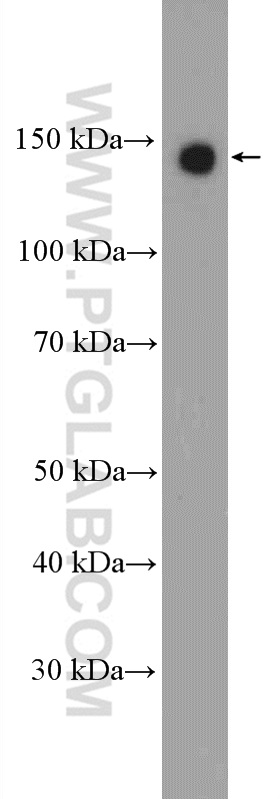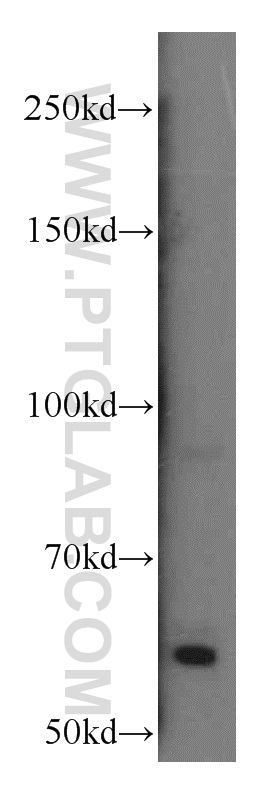验证数据展示
经过测试的应用
| Positive WB detected in | mouse kidney tissue, COLO 320 cells, HL-60 cells, Jurkat cells, mouse liver tissue |
推荐稀释比
| 应用 | 推荐稀释比 |
|---|---|
| Western Blot (WB) | WB : 1:2000-1:10000 |
| It is recommended that this reagent should be titrated in each testing system to obtain optimal results. | |
| Sample-dependent, Check data in validation data gallery. | |
产品信息
19125-1-AP targets Calcium Sensing Receptor in WB, IHC, IF, ELISA applications and shows reactivity with human, mouse, rat samples.
| 经测试应用 | WB, ELISA Application Description |
| 文献引用应用 | WB, IHC, IF |
| 经测试反应性 | human, mouse, rat |
| 文献引用反应性 | human, mouse, rat, goat |
| 免疫原 | Peptide 种属同源性预测 |
| 宿主/亚型 | Rabbit / IgG |
| 抗体类别 | Polyclonal |
| 产品类型 | Antibody |
| 全称 | calcium-sensing receptor |
| 别名 | Calcium Sensing Receptor, CAR, CASR, FHH, FIH, GPRC2A, HHC, HHC1, NSHPT, PCAR1 |
| 计算分子量 | 121 kDa |
| 观测分子量 | 120-140 kDa |
| GenBank蛋白编号 | NM_000388 |
| 基因名称 | Calcium Sensing Receptor |
| Gene ID (NCBI) | 846 |
| RRID | AB_10646434 |
| 偶联类型 | Unconjugated |
| 形式 | Liquid |
| 纯化方式 | Antigen affinity purification |
| UNIPROT ID | P41180 |
| 储存缓冲液 | PBS with 0.02% sodium azide and 50% glycerol pH 7.3. |
| 储存条件 | Store at -20°C. Stable for one year after shipment. Aliquoting is unnecessary for -20oC storage. |
背景介绍
CASR, also named as GPRC2A, PCAR1, belongs to the G-protein coupled receptor 3 family. Changes in extracellular calcium are thought to modulate a balance between proliferation and differentiation in a variety of cell types. The activity of CASR is mediated by a G-protein that activates a phosphatidylinositol-calcium second messenger system. It has been shown to play a major role in regulating parathyroid hormone secretion and subsequently influencing the calcium concentration of extracellular fluids. In normal primary keratinocytes and breast epithelial cells, proliferation is inhibited and elevated extracellular calcium levels trigger differentiation. Malignant transformations of these cell types are accompanied by a loss of responsiveness to the anti-proliferative effects of elevated extracellular calcium. Several disorders of calcium homeostasis have been linked to mutations in the CaSR. These include familial hypocalciuric hypercalcemia (FHH), neonatal severe hyperparathyroidism (NSHPT), and autosomal dominant hypocalemia (ADHypo). The 60-65 kDa band detected by this antibody might represent a degradation product of CASR (PMID: 15718278).
实验方案
| Product Specific Protocols | |
|---|---|
| WB protocol for Calcium Sensing Receptor antibody 19125-1-AP | Download protocol |
| Standard Protocols | |
|---|---|
| Click here to view our Standard Protocols |
发表文章
| Species | Application | Title |
|---|---|---|
J Ginseng Res Ginsenoside Rg1 attenuates mechanical stress-induced cardiac injury via calcium sensing receptor-related pathway | ||
Front Pharmacol Calcium Sensing Receptor-Related Pathway Contributes to Cardiac Injury and the Mechanism of Astragaloside IV on Cardioprotection. | ||
Phytomedicine Panaxytriol upregulates CYP3A4 expression based on the interaction of PXR, CAR, HSP90α, and RXRα.
| ||
Front Pharmacol Effects of Sodium Ferulate on Cardiac Hypertrophy Are via the CaSR-Mediated Signaling Pathway. | ||
J Ethnopharmacol Fructus Ligustri Lucidi aqueous extract promotes calcium balance and short-chain fatty acids production in ovariectomized rats. | ||
Acta Pharmacol Sin Astragaloside IV attenuates myocardial ischemia/reperfusion injury in rats via inhibition of calcium-sensing receptor-mediated apoptotic signaling pathways. |



